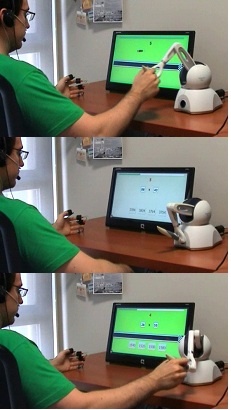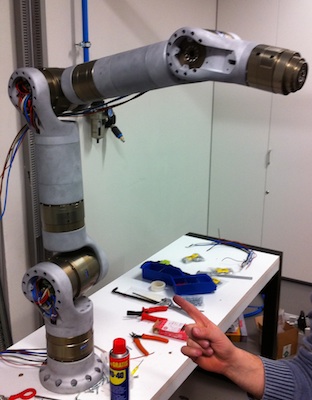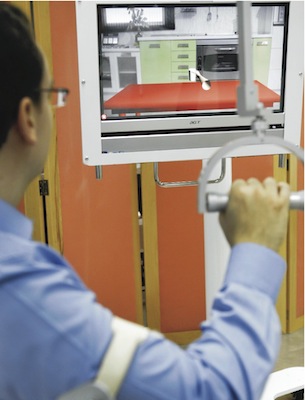Sep 1, 2011 , by
Public Summary Month 8/2011
The scientific activities carried out during the last two months (M7-M8) can be summarized as follows:
- Identification and implementation of the technique, suitable for MAAT project purposes, able to reconstruct human arm kinematics. It relies on the joint use of 2 magneto-inertial sensors located on the patient arm and position sensors embedded in the robot (Fig. 1).

- The system for monitoring the patient physiological state has been completed. It relies on sensors able to measure pulse, galvanic skin response, respiration and skin temperature (Fig. 2). The monitoring system has been tested on ten volunteer healthy subjects.
- Implementation in a simulated environment of a new control system grounded on a submovement-based trajectory planner that allows adapting robot accuracy and interaction force in unstructured environment (Fig. 3
 ). A comparison with a traditional PD torque control has also been carried out.
). A comparison with a traditional PD torque control has also been carried out. - The effect of vibrotactile stimulation will be evaluated. We are defining the experimental protocol.
- In order to deliver motor tasks of daily living activities during the robotic therapy and motivate the patient, a virtual realty environment has been developed (Fig. 4). The system adapts the performance according to residual ability of the patient.

Fig.1. - Arm kinematic reconstruction set-up: the subject performs the exercise with MIT-Manus system; the magneto-inertialsensors placed on upper arm and hand measure radial acceleration and orientation respectively.

Fig.2. - Physical/coordination task (top); Cognitive task (middle); Physical/coordination + Cognitive task (bottom)

Fig.3. - Block scheme of the control based on submovement composition

Fig.4. - The Virtual Reality environment reproducing activities of daily living
Aug 2, 2011 , by
Public Summary Month 6/2011
The activities carried out during the last two months (M5-M6) can be summarized as follows:
- Evaluation of different techniques to reconstruct human arm kinematics. Identification of the most suitable for MAAT purposes.
- Definition of a setup for patient physiological state analysis. Planning of tests to evaluate its performances.
- Evaluation of a vibrotactile stimulation system to increase patient motivation.
- Definition of a new controller grounded on a submovement-based trajectory planner that allows adapting the interaction force to the patient residual abilities and a PD torque control.
- Progress on the development of the immersive virtual reality system.
- Publications in international journals and conferences can be found in the public web site of the MAAT project (http://hal.umh.es/maat/Publications.html). Dissemination activities have been promoted also by means of the organization of one workshop and one journal special issue.
Apr 22, 2011 , by
Public Summary Month 4/2011
Main activities carried out during the first 3 months of the MAAT project (http://hal.umh.es/maat) are summarized in the following:
- Identification of the equipment for monitoring patient behavioral and physiological state
- Development of data processing techniques for analyzing patient kinematic and dynamic parameters (Zollo et al, 2010), (Zollo et al, 2011).
- Preliminary activities on the development of the adaptive interaction control system for the rehabilitation robot, based on nonlinear oscillators (Salerno et al., 2011).
- Development of the rehabilitation robot based on Schunk PRL modules
- Development of an immersive virtual reality system that will be dynamically modified according to the patient’s physiological reactions to the given robotic therapy (Morales et al, 2010).
Feb 2, 2011 , by
Public Summary Month 2/2011
The MAAT project aims at developing a new robotic system for the administration of highly sophisticated therapy to stroke patients able to (i) maximise patient motivation and involvement in the therapy and (ii) continuously assess the progress of the recovery from the functional and neurological viewpoint, with special attention to the issue of safety in human-robot interaction. The main novelty of the MAAT approach is to close patient in the loop and use multi-sensory data (such as motion, forces, voice, muscle activity, heart rate, skin conductance etc.) to adaptively and dynamically change complexity of the therapy and real-time displays of an immersive virtual reality system in accordance with specific patient requirements.
During the first three months of the project, the following activities have been carried out by UCBM and UMH:
1- Coordination and Management
Activities of coordination and management have been carried out since project beginning. They also include ethical issues management because of the project purpose of monitoring subjects behavioral and physiological data. To this regard subject information sheet and informed consent have been prepared.
2- Scientific activities
2.1- In order to indentify the equipment for monitoring patient behavioral and physiological state, a state of the art on this topic has been carried out.2.2- Data processing techniques for analyzing patient kinematic and dynamic parameters have been carried out exploiting MIT-Manus robot and 2 magneto-inertial sensors (XSense MTx), available at UCBM, placed on upper limb. Preliminary experimental results can be found in (Zollo et al, 2010), (Zollo et al, 2011).

2.3- The activities described in Sub-Tasks 2.4 and 2.5 started correctly at month two. The analysis of the state-of-the-art in the evaluation of patient’s intention and physiological state has been reported. Based on the information analyzed about evaluation of patient’s intention and physiological state, a ser of target devices has been identified like: ECG electrodes, Electrodermal response (GSR), Respiration, Blood pressure, Skin temperature, Pulse, EMG sensors. Patients using a rehabilitation robot might need additional extrinsic feedback to stay informed about limb position, collision, contact with items in virtual environments, etc. Vibration, temperature and skin-stretch stimulation are intuitive ways to provide extrinsic feedback related to limb position and collisions/contact



2.5- The main goal of the Sub-Task 3.2 is the development of an immersive virtual reality system that will be dynamically modified according to the patient’s physiological reactions to the given robotic therapy in order to maximize the patient’s motivation and the therapy outcomes. The stimulation systems described in Sub-Task 2.5 is being integrated with the virtual reality (VR) system developed in this task in order to stimulate the patient in a similar way that a therapist would do it (Morales et al, 2010).

(Morales et al, 2010) Morales, R.; Badesa, F.J.; Domenech, L.M.; Garcia-Aracil, N.; Sabater, J.M.; Menchón, M.; Fernandez, E.; Design and control of a rehabilitation robot driven by pneumatic swivel modules Biomedical Robotics and Biomechatronics (BioRob), 2010 3rd IEEE RAS and EMBS International Conference on, 26-29 Sept. 2010
(Zollo et al, 2011) Zollo L, Accoto D, Sterzi S, Guglielmelli E. Rehabilitation Robotics, Therapeutic Robotics. Springer Handbook of Medical Technology, K. Rüdiger, K.-P. Hoffmann, R.S. Pozos, (Eds.), Chap. 44, 2011 (ISBN: 978-3-540-74657-7).








